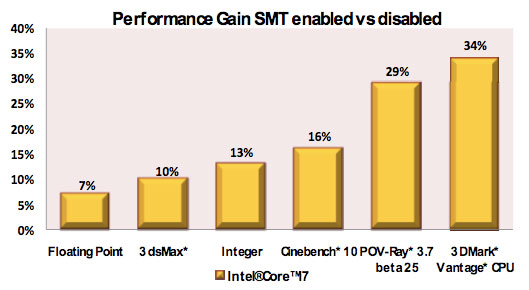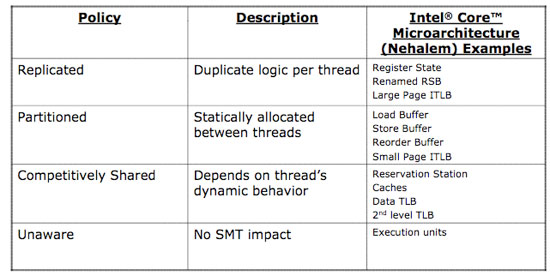Nehalem - Everything You Need to Know about Intel's New Architecture
by Anand Lal Shimpi on November 3, 2008 1:00 PM EST- Posted in
- CPUs
...and Now We Understand Why: Hyper Threading
Years ago I asked Pat Gelsinger what he was most excited about in the microprocessor industry, he answered: threading. This was during the early days of Hyper Threading but since the demise of the Pentium 4, we never really got another look at HT on any of the subsequent microprocessors based on Core.
Hyper Threading was Intel’s marketing name for simultaneous multi-threading (SMT), the ability to fetch instructions from two threads at the same time instead of just a single one. The OS sees a HT enabled processor as multiple processors, in this case two, and send two threads of instructions to the CPU.
Nehalem sees the return of Hyper Threading and it is met with much, much better performance than we ever saw with Pentium 4 for a number of reasons:
1) Nehalem has much more memory bandwidth and larger caches than Pentium 4, giving it the ability to get data to the core faster and more predictably
2) Nehalem is a much wider architecture than Pentium 4, taking advantage of it demands the use of multiple threads per core.
Just as the first Pentium 4 didn’t ship with Hyper Threading support, the architectures that Nehalem was derived from didn’t have HT either. The time is right with Nehalem for the reasons mentioned above and because there are simply many more applications that can take advantage of HT today than ever before.
The chart below shows the performance gain from enabling HT on a Nehalem processor, no other variables were changed:

Just like on Atom, enabling HT on Nehalem required very little die area. Only the register state, renamed return stack buffer and large page instruction TLBs are duplicated. The rest of the data structures are either partitioned in half when HT is enabled or are “competitively” shared, in that they dynamically determine how much of each resource is allocated per thread:

Enabling HT was a very power efficient move for Nehalem, and you can expect that it will improve performance in a number of applications - far more regularly than it ever did with the Pentium 4.
Now it should also make sense why Intel increased buffer sizes in Nehalem, because many of those buffers now have to deal with ops coming from two threads instead of just one. That’s more instructions to decode, better utilization of the front end, more micro-ops in the pipeline, more micro-ops in the re-order engine and more micro-ops executing concurrently.










35 Comments
View All Comments
qurious69ss - Friday, August 22, 2008 - link
You sound like one of those sad fanboys from amdzone. Tell dimentia to get a life.X1REME - Friday, August 22, 2008 - link
wow, this whole cpu is a copy of a amd cpu and you expect amd fan boys to not get amd with you, secondly this fantasy is baseless until you can compare it to an offering from the AMD team (Shanghai & Deneb). AMD is still KING with there OPTERON and most likely will be in the future with there new cpu coming soon for the server and also for the desktop.DigitalFreak - Friday, August 22, 2008 - link
Learn to spell, you goober.X1REME - Friday, August 22, 2008 - link
OK DORK, am sure you have never made a mistake (there=their) Duh. I bet your some kid all hyped up for the i7 who wishes Xmas comes early lol. Anyway it’s not a desktop chip, it’s a sever chip DUH. It’s meant to compete with the AMD Opteron chip (the best). Although Opteron will lose its crown, it won’t be to i7 but to Shanghai (AMD new latest and greatest). And like I said b4, Deneb will clear anything up out of place.The reason amd does not grab a microphone and star shouting at the top of their voice is because amd doesn't have the resources and money in comparison with Intel. If it reveals too much about its future strategy and Intel likes that strategy (like the Opteron, HT, On-board mem etc) there is a big theoretical chance that Intel could take this idea and deliver a product well before AMD. So it’s not over until amd says its.
snakeoil - Thursday, August 21, 2008 - link
nehalem fails,it was supposed to be superior to core 2, intel was against the wall this time, why?, because, the old front bus architecture was lagging more more in the server arena and becoming a bottleneck ,compared to hypertransport, so intel is forced to abandon the front side bus, but the strong point of core 2 is that because you don't have and integrated memory controller you can stuff the processor with a huge L2 cache.so, nehalem sucks in gaming,there is no way that the enthusiast is going to pay more for a processor that produce less fps that they actually have.
and the hyperthreading is a risky move, hypertrheading is known por being power hungry, and although produce gains in some applications,some servers applications actually runs slower, so in many cases the old hyperthreading had to be disabled.
nehalem is crippled for the enthusiast,and the regular user.
nuff said.
AssBall - Saturday, August 23, 2008 - link
You musta missed where Anand says several times its not intended for better gaming? It will be significantly faster than Penryn for multithreaded applications. I guess I don't see how this makes it "fail". Maybe in your fantasy world where 90% of the CPU market are "enthusiasts".snakeoil - Saturday, August 23, 2008 - link
enthusiasts drive the market you fruityassUnlimitedInternets36 - Saturday, August 23, 2008 - link
LOL this year Satan err Santa is going to take away your PC because you don't deserve to have one anymore You Jaded nerd.Gasaraki88 - Friday, August 22, 2008 - link
Thanks! I never knew there was a expert on CPU design in the house. I've learn so much from your well researched, tested and thought out comment...pool1892 - Friday, August 22, 2008 - link
first of all the enthusiast market is a very tiny niche, it would not kill intel if you were right.but you are not. the L2 of penryn (and banias) is much more like the nehalem L3 than the nehalem L2. and if you have a single threaded game it now has 8mb at similar latencies, but with a second buffer, the 256k L2, and a MUCH smaller cache miss penalty.
concerning hyperthreading: please read the article first. nehalem switches off what it does not need, powerwise. and about fiftytwo other very vaild arguments.